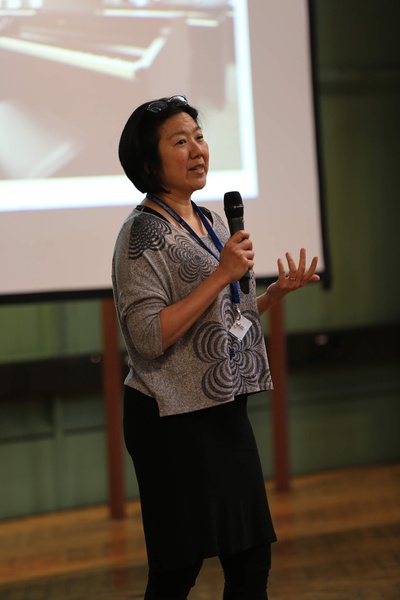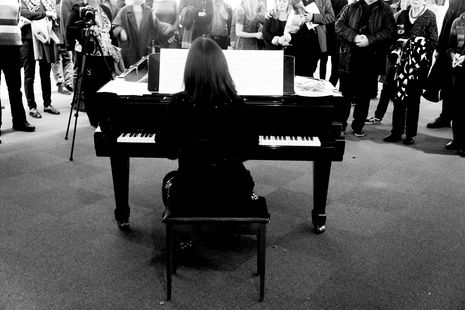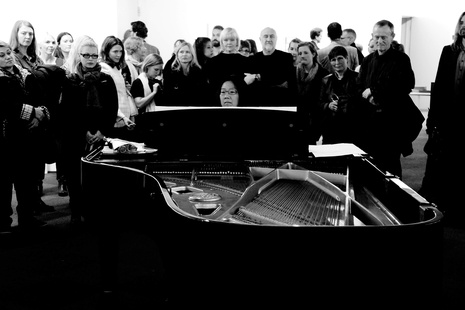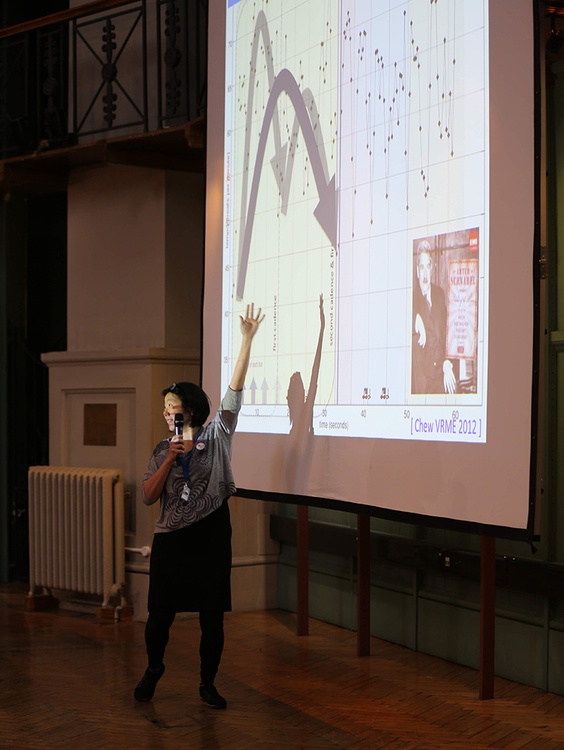Structures musicales et arythmie cardiaque
Chercheuse CNRS, pianiste, Elaine Chew a rejoint l'équipe Représentations musicales du laboratoire STMS au printemps 2019. Elle mène et dirige des recherches sur la représentation mathématique et l'analyse computationnelle des structures musicales, appliquées à la composition musicale, à la cognition, à l'expressivité, ainsi qu'aux traces électrocardiographiques d'arythmies. Nous avons été à sa rencontre.
 Elaine Chew, vous êtes lauréate de l'appel Advanced Grant 2018 du Conseil européen de la Recherche pour diriger le projet COSMOS (Computational Shaping and Modeling of Musical Structures). Vous avez choisi le CNRS et rejoint l'équipe Représentations musicales de l'UMR Sciences et technologies de la musique et du son (STMS) à l'Ircam pour mener cette recherche. Pouvez-vous nous expliquer ce choix ?
Elaine Chew, vous êtes lauréate de l'appel Advanced Grant 2018 du Conseil européen de la Recherche pour diriger le projet COSMOS (Computational Shaping and Modeling of Musical Structures). Vous avez choisi le CNRS et rejoint l'équipe Représentations musicales de l'UMR Sciences et technologies de la musique et du son (STMS) à l'Ircam pour mener cette recherche. Pouvez-vous nous expliquer ce choix ?
Le laboratoire mixte de recherche STMS de l’Ircam est un centre de recherche en musique informatique à la longue et prestigieuse histoire, internationalement reconnu en même temps que profondément ancré dans la pratique musicale. Il accueille la plus grande concentration au monde de chercheurs travaillant à plein temps sur tous les aspects de la musique, assurant aux jeunes chercheurs et compositeurs associés une formation des plus pointues et exigeantes. Rares sont les lieux où la recherche musicale est ainsi menée dans un environnement aussi favorable, où que ce soit dans le monde. Au sein de STMS sont réunis le CNRS, l’Ircam, Sorbonne Université et le ministère de la Culture français. Parmi ces institutions, le CNRS accueille le plus grand nombre de boursiers ERC (European Research Council), et leur offre d’excellentes infrastructure et expérience pour les accompagner dans leurs recherches ERC.
Ma propre histoire avec l’Ircam remonte à 2002, lorsque Michel Fingerhut, alors directeur de la médiathèque de l’Ircam et illustre organisateur d’une des premières conférences de la International Society for Music Information Retrieval (ISMIR), m’a contactée à l’université de Californie du Sud (USC) de Los Angeles. Accompagnée de mes collègue Shrikanth Narayanan et Jay C.-C. Kuo, nous venions tout juste de remporter la deuxième bourse jamais attribuée par la National Science Foundation (NSF) pour la recherche MIR, et Michel m’écrivait pour m’inviter à participer à ISMIR. C’est à peu près à cette époque qu’il m’a présentée à Gérard Assayag, à la tête de l’équipe Représentations musicales. Depuis, de nombreux collaborations et échanges ont eu lieu entre mes laboratoires successifs de recherche à l’USC puis à l’université de Londres Queen Mary (QMUL) et l’équipe Représentations musicales de l’Ircam, avec à la clef des présentations, des concerts, et une organisation conjointe de l’Atelier international des conversations mathémusicales à l’Université nationale de Singapour. Plus récemment, j’ai fait partie du conseil scientifique de l’Ircam et j’ai eu l’opportunité de me tenir au courant des dernières innovations du laboratoire STMS.
Au vu du contexte du milieu de la recherche et de mon parcours professionnel, le choix était naturel d’asseoir ce projet COSMOS, AdG du ERC, sur le CNRS et STMS.
COSMOS vise à étudier des structures musicales créées lors de performances mais également lors de séquences d'arythmie cardiaque. Comment liez-vous structures musicales et arythmie cardiaque ?
L’arythmie cardiaque est un trouble médical provoqué par des dysfonctions affectant les influx électriques du cœur. En résulte des rythmes cardiaques anormaux, qui peuvent être très musicaux. On constate de nombreuses similitudes rythmiques et temporelles entre les signaux cardiaques et musicaux. Par exemple, la fibrillation atriale, une arythmie fréquente qui affecte plus de 8.8 millions de personnes de plus de 55 ans aux États-Unis, suit un rythme irrégulier qui peut évoquer le free jazz ou certains discours musicaux contemporains. Toutefois, parce que les rencontres entre les disciplines musicales et cardiologiques sont rares, les méthodes de représentation de l’information en musique et en signaux cardiaques, ainsi que leurs approches analytiques respectives, ont été développées de manière totalement indépendante.
Quand j’étais doctorante, et que je bénéficiais des conseils en musique de chambre de la part du violoniste Lynn Chang au MIT, il me parlait de l’importance de la « divine pulse » – nous jouions alors des musiques pourvues d’une pulsation. Rythme, pulse, temporalité font partie des aspects les plus viscéraux de la performance musicale, plus encore, peut-être, que les hauteurs, l’harmonie et la mélodie. Au fil des siècles, les musiciens, qui sont les pourvoyeurs du temps, ont développé de nombreuses manières de représenter et de parler du rythme, dans son acception la plus large. Avec l’avènement des ordinateurs et autres technologies numériques, les scientifiques de la musique ont mis au point en parallèle des outils et des techniques analytiques pour quantifier les propriétés du temps et de la fréquence musicaux, et leurs variations, qui importent tout particulièrement dans le cadre des études de l’interprétation.
La manière dont les musiciens conceptualisent et organisent le temps est potentiellement utile au développement de la discipline e-cardiologique. Pour donner un exemple, les arythmies sont grossièrement catégorisées en fonction de leur vélocité – les tachycardies sont rapides, les bradycardies sont lentes –, de leur régularité – les tachycardies sont rapides et régulières, les fibrillations sont rapides et irrégulières – et de leur source – atriale, ventriculaire ou jonctionnelle. Nul musicien qui se respecte ne se satisferait d’une description aussi pauvre de la musique : rapide, régulière et dans le registre medium. Être en mesure de qualifier les comportements arythmiques au-delà des grossières classifications existantes en recourant à des descripteurs musicaux est susceptible d’aider à stratifier plus finement les arythmies en sous-groupes, afin de mieux en décrire les symptômes et en déduire des traitements.
Vous êtes chercheuse mais également pianiste virtuose. Comment conciliez-vous votre activité de recherche et celle de musicienne ?
Il n’y a selon moi nul conflit intellectuel à être à la fois chercheuse et musicienne – être musicienne fait de moi une meilleure chercheuse et inversement –, la seule contrainte est le temps – trouver le temps pour la recherche et pour la pratique de l’instrument. Et, peut-être, la nécessité de contredire les préjugés sur ce qu’est un chercheur (i.e. un musicien médiocre) et ce qu’est un musicien (i.e. un être plus intuitif qu’analytique, exceptions faites de Pierre Boulez, Leonard Bernstein, etc.).


Elaine Chew lors de l'inauguration officielle du Musée d'art moderne Kunsthall Stavanger en Norvège, 2013
L’acte d’interpréter s’accompagne d’une incarnation enrichie par le savoir musical, qui dépasse de loin le geste physique du jeu instrumental. Les grands interprètes sont aussi des penseurs aiguisés – capables de déconstruire la musique pour la reconstruire ensuite en lui donnant du sens – et des communicants éloquents – susceptibles de concevoir de nouveaux modes d’écoute pour l’auditeur, et de les mettre en œuvre sur leurs instruments. Ce savoir est souvent non-dit, et relégué au domaine de l’intuition. Une large partie de mes activités de recherche vise justement à dévoiler et à concrétiser ce savoir caché.
Votre participation le 12 mars 2019 au « Women in Mathematics Days » organisé par la London Mathematical Society semble témoigner de votre intérêt sur la place de la femme dans la recherche. Quelle est votre position sur le sujet ?
 Nous sommes trois chercheuses seniors au STMS, moi incluse, ce qui représente un peu moins de 10% de l’équipe de recherche. Le laboratoire STMS lui-même est dirigé par une femme, Brigitte d’Andrea-Novel, qui est professeure à l’université de la Sorbonne et à l’École des Mines, spécialiste des théories du contrôle, et directrice de la musique au Festival des Mines. Dans le monde entier, la réputation des Women in Science and Engineering (WiSE, Femmes de sciences et ingénieures) gagne du terrain, de même que la popularité des femmes compositrices et cheffes. En outre, la parité homme-femme et l’égalité de traitement des femmes sont actuellement des sujets de préoccupation essentiels au CNRS, comme en témoigne, entre autres choses, la lettre ouverte de son président-directeur général Antoine Petit, adressée à toutes les femmes de l’institution en juillet dernier, encourageant celles qui y sont éligibles à candidater aux divers concours, promotions et autres postes à responsabilité. La situation devrait donc s’améliorer.
Nous sommes trois chercheuses seniors au STMS, moi incluse, ce qui représente un peu moins de 10% de l’équipe de recherche. Le laboratoire STMS lui-même est dirigé par une femme, Brigitte d’Andrea-Novel, qui est professeure à l’université de la Sorbonne et à l’École des Mines, spécialiste des théories du contrôle, et directrice de la musique au Festival des Mines. Dans le monde entier, la réputation des Women in Science and Engineering (WiSE, Femmes de sciences et ingénieures) gagne du terrain, de même que la popularité des femmes compositrices et cheffes. En outre, la parité homme-femme et l’égalité de traitement des femmes sont actuellement des sujets de préoccupation essentiels au CNRS, comme en témoigne, entre autres choses, la lettre ouverte de son président-directeur général Antoine Petit, adressée à toutes les femmes de l’institution en juillet dernier, encourageant celles qui y sont éligibles à candidater aux divers concours, promotions et autres postes à responsabilité. La situation devrait donc s’améliorer.
La faible représentation féminine parmi mes pairs au cours de mes études (j’étais souvent la seule femme, ou l’une des deux seules femmes), en cursus d’informatique, en licence et master de mathématiques et jusqu’au doctorat, m’a moins dérangée que lorsque j’ai pu constater de mes propres yeux, en tant que chercheuse professionnelle, la manière dont les femmes sont désavantagées, avec des retards d’avancement et de promotion, et la manière dont elles sont souvent cantonnées à des travaux « d’entretien » plutôt qu’à des travaux plus « glamour » sous le feu des projecteurs. Je n’ai donc pas pu m’empêcher de m’intéresser, peut-être de manière égoïste, aux perspectives des femmes dans le milieu de la recherche.
En tant que professeure assistante, j’ai eu la chance d’avoir des dirigeants éclairés et de bénéficier des programmes généreux de WiSE, qui aspiraient à rendre le terrain plus égalitaire. J’ai aussi pu constater combien la présence d’un rôle modèle féminin (ou issu d’autres minorités) peut bouleverser le paysage de la recherche, en remettant en question les stéréotypes et les attendus quant à ce que doit être le leadership. J’avoue être très heureuse de constater que mes anciens étudiants et post-doctorants (autant les femmes que les hommes) sont devenus des champions de la cause de WiSE, lançant et dirigeant l’initiative Women in MIR (WiMIR), qui propose divers mentorats et ateliers. Ils ont accompli bien plus que ce que je n’aurais jamais pu faire.
Pour qu’une organisation fonctionne de manière optimale dans un environnement compétitif, elle doit pouvoir tirer le meilleur parti des capacités et des atouts de tous les membres de ses équipes, aussi bien les femmes que les hommes. Des études ont prouvé que la présence de femmes dans une réunion de direction améliore les prises décisions stratégiques et les performances. S’assurer que toutes les voix sont entendues ne doit pas être le fait des seules femmes ; il est important qu’hommes et femmes s’impliquent ensemble pour cela.
Photo : Elaine Chew au Women in Mathematics Days, 2019


